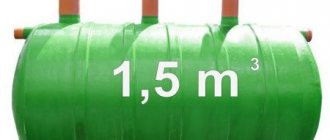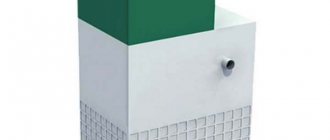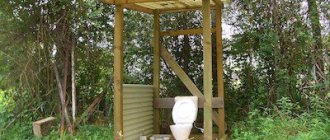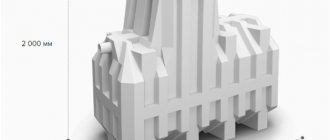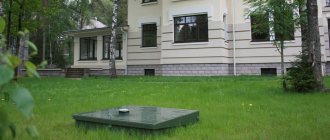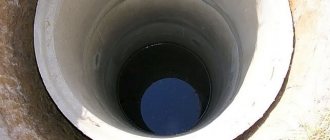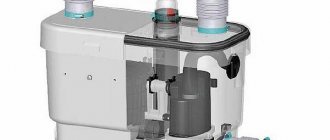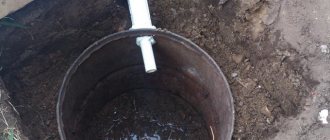About the manufacturer
The Russian company is engaged in the design, production and installation of autonomous sewer systems. The products are made from polymer materials. Wastewater treatment systems are available in various capacities. All company products are certified and meet the highest quality standards.
The products of Terra Los LLC are characterized by:
- high level of environmental safety;
- durability (it is not subject to corrosion and can work effectively for more than 50 years);
- resistance to groundwater and low temperatures;
- special strength (made of multilayer polyethylene, the wall thickness of the products is 25-50 mm, the tanks have a minimum number of welds, the outer surface of the tanks is reinforced).
Scope of use
Septic tanks are a modern alternative to cesspools. They are designed for drainage, collection and treatment of domestic wastewater in private households.
The units consist of several sealed chambers connected to each other. The number of chambers directly affects the quality of water purification.
Note! Terra septic tanks, according to the technical specifications stated by the manufacturer, purify water by 98%, regardless of modification.
Conventional layout and installation diagram
How Terra works
In appearance, the septic tank resembles a vertical container, which is divided into 5 chambers, where mechanical and biological cleaning occurs using compressed air. The process is called aeration, that is, it is an artificial supply of air, which is necessary for the oxidation of organic substances.
It is oxidative processes that are necessary for the life of bacteria, but air must be present. According to manufacturers' indications, purification is 98 percent. The cleaning process is especially good when a combined method is used. Reviews left on the forums confirm that this is the main advantage of the Terra septic tank.
The system can operate for another five hours after a power outage. There is a drawback to the operation of this system, that during a power outage it is necessary to reduce water consumption; if this is not done in time, anaerobic processes will begin, an unpleasant odor will appear, and the station itself will overflow. Such a system requires constant monitoring and in the absence of owners, the septic tank in such a situation will quickly fail.
Principle of operation
The wastewater treatment process proceeds as follows:
- Water from the house's sewerage system flows by gravity into the first container. It separates into heavy sediment and a light component. Sludge, consisting of feces and other waste that ends up in the sewer, settles to the bottom of the chamber, and the settled water flows into the second chamber through the overflow pipe.
- Aeration and oxidation occur in the intermediate chambers. Also at this stage, the process of cleansing and clarification occurs due to the work of bacteria.
- The last chamber receives water suitable for reuse, for example, for irrigation. It is pumped out of the tank forcibly using a pump.
The lineup
Terra septic tanks are available in two versions:
- Practitioner (vertical 4 chamber). They have the prefix PR in their name.
- Horizon (horizontal 3 chamber).
Each of the modifications is represented by units of varying power. The thickness of the reinforced walls, depending on the model, is 12-16 – 25-50 mm.
Terra PR (Practitioner)
It is a vertically located cylindrical container. On the outer surface there are stiffening ribs that provide effective resistance to compression.
Tanks are produced with a volume of 1.2 to 5 cubic meters, designed to serve from 3 to 20 people.
The vertical arrangement allows you to install a septic tank in a small area. However, there is a need to dig a deep pit.
Terra Horizon
They are horizontally located cylindrical containers with one or two necks. The outer surface is reinforced with stiffening ribs.
The containers are available in volumes from 2 to 5 cubic meters. Capable of serving from 3 to 10 people.
The horizontal position of the septic tank allows installation without digging a pit that is too deep. However, placing a horizontal container requires additional space on the site.
External view of the Terra Horizon installation
Finished goods
Now let's study ready-made septic tanks from different manufacturers and try to decide which is better.
Septic Tank - 1: inexpensive entry-level solution.
In front of us is a simple single-chamber septic tank with inflow and overflow pipes and a hatch located half a meter above the lid for cleaning. Here are its main characteristics:
- Volume: 1200 liters;
- Number of users : up to 3 people;
The maximum number of septic tank users depends on the average daily water consumption of each of them.
- capacity : 600 liters per day;
- Overall dimensions : 1.2x1x1.7 meters;
- Price : 35,000 rubles.
Two-chamber septic tank Tank-3: increased productivity and improved cleaning quality.
The older model added another camera. Accordingly, when installing a septic tank, two hatches are brought to the surface for pumping. Here are other characteristics of the treatment plant:
- Volume : 3000 liters;
- Number of users : 5-6 people;
- Capacity : 1200 liters per day;
- Dimensions : 2.2x1.2x2 meters;
- Price : 72,000 rubles.
Septic tank with three settling chambers Triton-T5.
The cylindrical plastic septic tank accommodates three settling chambers. One of them is equipped with a biofilter, which facilitates more complete processing of organic waste by aerobic bacteria. Through a single hatch, sludge can be pumped out from all three chambers.
Let's look at the characteristics of the septic tank:
- Volume : 5000 liters;
- Number of users : up to 10 people;
- Overall dimensions : diameter 1.2 meters with length 4.72 m;
- Wall thickness : up to 40 mm;
- Price : 85,000 rubles.
All the septic tanks we have studied up to this point require the construction of a separate drainage well or filtration field. The quality of water purification does not allow it to be discharged onto the terrain.
Septic tank Terra is an autonomous, energy-dependent treatment plant with a cleaning quality of up to 98%.
Strictly speaking, this is not a septic tank, but a deep biological treatment station. Thanks to the air compressor responsible for aerating the wastewater, organic matter is processed to the state of inert and completely odorless sludge.
The septic tank is designed for installation in the ground below the freezing level. However, by installing a drainage pump for forced pumping of purified water, it can be placed in a warm basement of the house.
Housing material: low-density polyethylene. The cylindrical shape and stiffening ribs perpendicular to the vertical axis of the septic tank provide maximum resistance to soil pressure. The wall thickness of older models reaches 50 mm.
Let's study the characteristics of a septic tank using the Terra 5 model as an example:
- Overall dimensions : diameter 1.25 meters with height 2.6 m;
- Capacity : 1200 liters per day;
- Maximum salvo discharge volume : 250 liters;
- Weight : 270 kg;
- Power consumption : 60 W;
- Price : 84,200 rubles.
Septic tank Topas provides 99% quality of wastewater treatment.
Before us is another deep biological treatment station. Its creators used all available methods to improve the quality of the output water - several series-connected settling chambers, aeration and a biofilter.
Main components of the Topas treatment plant.
Here are the technical characteristics of the Topas5 septic tank:
- Capacity : 1000 liters per day;
- Salvo discharge : 220 liters;
- Number of users : up to 5 people;
- Electrical power consumption : 60 watts;
- Weight : 220 kg;
- Dimensions : 1.15x1.17x2.5 meters;
- Price : 98,000 rubles.
The Astra line of septic tanks from the Unilos company.
The Astra septic tank is designed in the same way as the previous one - four series-connected chambers, an aeration tank (aeration chamber) and a biofilter. Cleaning quality - up to 98%.
The characteristics of Unilos Astra 5 are also quite close to the parameters of the previous model:
- Capacity - 1000 liters per day;
- Maximum salvo discharge - 250 liters;
- Power consumption - 60 W;
- Dimensions - 1.12x1.12x2.36 m.
The advantage of Astra is its relatively low price: at the time of writing (January 2021) it can be purchased for 76,000 rubles. Which of the septic tanks we studied should the buyer prefer?
In my opinion, Unilos Astra provides the optimal balance between cost and quality of cleaning. If in your region the price ratio differs from that given in this material, feel free to take the deep cleaning station that is cheaper.
A biological treatment station will not take up much space in your yard.
But energy-independent septic tanks, alas, turn out to be uncompetitive. With a cost close to that of deep treatment stations, they require the mandatory construction of a filter well or filtration field.
Homemade settling tanks, made from scrap materials, are much cheaper and are not inferior to factory products in functionality.
Plastic containers are so expensive due to their high material consumption. Large wall thickness is needed in order to withstand soil pressure.
Autonomous sewage systems
Terra vertical and horizontal septic tanks are the main element of autonomous installations for collecting and treating wastewater. In addition to the tank itself, autonomous sewer stations are equipped with;
- compressor (installs HIBLOW-XP, HP (Japan) or THOMAS units);
- control system;
- stabilizer and stationary sludge pumping device;
- ventilation device (located in the septic tank on the hatch);
- pipe aerators "Matala";
- three-layer reinforced air supply hoses;
- fittings;
- couplings;
- distribution comb.
Internal device
At the customer's request, Terra stations are additionally equipped with an alarm system and a pump for forced release.
Note! If the power supply is interrupted, the Terra station can operate in wastewater reception mode for up to 5 hours. Once the voltage supply is restored, the unit returns to normal operation.
Terra Los LLC produces autonomous sewer systems of various capacities.
The lowest-power installation is the Terra 3 septic tank. The station has the smallest dimensions of 1.2x2 m. The weight of the Terra 3 septic tank is 150 kg, the productivity does not exceed 300 liters per day. The Terra 3 septic tank can withstand a burst discharge of up to 150 liters.
The most popular, according to reviews from companies involved in installing sewer systems, are the Terra 5 PR and Terra 8 PR septic tanks. Both of these stations are equipped with tanks with a diameter of 1300 mm, but with different heights and weights of 2.1 m and 270 kg (Terra 5 PR septic tank) and 2.3 m and 320 kg (Terra 8 PR).
The technical characteristics of these and other stations can be viewed in the table.
| Terra autonomous system model | Installation dimensions, m | Power consumption, W | Weight, kg | Volume, cubic meters/day. | Volley. reset, l |
| 3 | 1.2x2 | 50 | 180 | 0.6 | 150 |
| 3 PR | 1.2x2 | 50 | 180 | 0.6 | 150 |
| 3 Long | 1.2x2.5 | 50 | 220 | 0.6 | 150 |
| 4 | 1.25x2.1 | 60 | 240 | 0.8 | 200 |
| 4 PR | 1.25x2.1 | 60 | 240 | 0.8 | 200 |
| 4 Long | 1.25x2.6 | 60 | 290 | 0.8 | 200 |
| 5 | 1.3x2.1 | 60 | 270 | 1.2 | 250 |
| 5 PR | 1.3x2.1 | 60 | 270 | 1.2 | 250 |
| 5 Long | 1.3x2.6 | 60 | 310 | 1.2 | 250 |
| 8 | 1.3x2.4 | 80 | 320 | 1.6 | 350 |
| 8 PR | 1.3x2.4 | 80 | 320 | 1.6 | 350 |
| 8 Long | 1.3x2.9 | 80 | 350 | 1.6 | 350 |
| 10 | 1.35x2.5 | 100 | 380 | 2 | 500 |
| 10 PR | 1.35x2.5 | 100 | 380 | 2 | 500 |
| 10 Long | 1.35x2.9 | 100 | 420 | 2 | 500 |
| 20 | 1.75x2.5 | 150 | 540 | 4 | 800 |
| 20 PR | 1.75x2.5 | 150 | 540 | 4 | 800 |
| 20 Long | 1.75x3 | 150 | 610 | 4 | 800 |
Note! Models with the Long prefix have large dimensions and total weight due to the elongated tank neck. This is their only difference from the basic modifications with a vertical container arrangement.
First meeting
A septic tank is a local treatment facility designed to separate wastewater into dense fractions and purified water. Water makes up 98-99% of the volume of domestic wastewater; after cleaning, it is simply absorbed into the soil. Sludge and solid waste can be used as fertilizer or removed by a sewer truck.
How does a septic tank differ from a sealed cesspool in terms of operation? Incomparably lower overhead costs. I will give an example from my own experience:
- The cesspool in my house required calling the cesspoolers every 2-3 weeks. Each trip of the miracle machine cost 1,200 rubles (data for 2013, now the cost of pumping a 4-cubic cesspool is already 2,000-2,200 rubles);
- A septic tank under the same conditions and with increased water consumption after the birth of a daughter needs to be pumped out no more than once a year.
How it works
The simplest septic tank consists of:
- Sump . Within a few days, the wastewater in it is divided into light fractions that float and form a dense crust on the surface of the water (paper, feces), silt that settles to the bottom (sand, food waste) and relatively clean water in the middle of the container;
- An overflow of a special design that draws water below the surface level of the sump;
As an overflow, it is customary to use a regular sewer tee installed vertically. Its lower outlet takes water from a shallow depth, and the upper one serves to clean out blockages.
- Drainage (filter) well , in which settled water is absorbed into the soil.
Where soil characteristics do not allow digging a drainage well, a filtration field is constructed. Drainage pipes are laid in the ground below the freezing level on a bed of crushed stone. On top they are covered with another layer of crushed stone and a soil cushion.
But excuse me, is it really impossible to replace the septic tank with an ordinary well with a soil bottom? Wouldn't water be absorbed in it the same way as in a filter well?
It will, but only for a short time. The bottom will silt very quickly and runoff will begin to accumulate. In addition, contamination of groundwater with untreated wastewater in Russia is punishable by administrative, and in case of severe consequences (poisoning, death of livestock) - also by criminal liability.
A single-chamber septic tank cleans wastewater by 60-80%. The remaining 20-40% passes through the settling tank and ends up in a filter well or filtration field. Silt gradually reduces the absorption capacity of the soil and, accordingly, the productivity of the treatment plant.
Fortunately, there are a number of ways to make your septic tank treat wastewater more efficiently:
- Several settling tanks connected in series. In each of them there remains a certain amount of sludge and light fractions. The more containers in the chain, the higher the quality of cleaning;
- Sump tank aeration . Air oxidizes organic matter, reducing its volume. More importantly, it promotes the proliferation of aerobic bacteria that feed on organic compounds;
- Biofilters . This is the name for flow-through containers filled with plastic washcloths, brushes or any other products with a large surface area. When filling the biofilter, aerobic bacteria again multiply, devouring organic waste.
The most effective septic tanks can remove up to 99% of contaminants from wastewater. The water leaving such a treatment plant (the so-called deep biological treatment plant) is transparent and completely free of sewage odor. It can be used for irrigation or simply dumped onto the terrain (into a drainage ditch or the nearest body of water).
Calculation
How to calculate a septic tank?
First, let's find out what exactly needs to be calculated. The task consists of two points. We need to calculate:
- Sump volume required for wastewater separation. If the septic tank does not retain them for a long time, the degree of water pollution at the outlet of the sump will decrease slightly;
- The area of the absorbent surface of a drainage well or filtration field. It is selected according to the performance of the treatment plant and depends on the type of soil.
Let's turn to the regulatory documentation. According to SNiP 2.04.03-85, when the wastewater flow rate is less than 5 cubic meters per day, the septic tank must have a full volume that is three times the daily flow rate. The total volume means the total capacity of all settling tanks (if there are several of them).
If the wastewater flow exceeds 5 m3/day, the settling tank is calculated at 2.5 times the daily flow.
How to find out how much waste flows into the sewer per unit of time? It’s as simple as that: look at the water meter readings. I already wrote above that 98-99% of the wastewater volume is hot and cold water.
By adding up the changes in the readings of the hot water and cold water meters per day, you will get the wastewater flow.
If there is no water meter or part of the consumed water does not end up in the sewer (used for watering, washing the car, etc.), be guided by sanitary standards (300 liters per person per day). Let's say, for a family of four, you need a septic tank with a sump volume of 300x4x3 = 3600 liters (3.6 cubic meters).
Let's move on to drainage. The absorption capacity of different soils is as follows:
| Image | Type of soil and its absorbency |
| Sand : 90 liters per day per square meter | |
| Sandy loam : 50 l/day per 1 m2 | |
| Loam : 25 l/day per 1 m2 | |
| Clay : 10-12 l/day per 1 m2 |
So, in our example with a family of three, a filter well dug in sandy loam soil should have a wetted surface of the bottom and walls of 300x4/50 = 24 m2. The side and bottom walls of an ideal cube with a side length of 2.2 meters will have this area.
How to calculate the required volume of a septic tank
You can calculate the volume of a septic tank required for a particular home yourself. The calculation is based on the number of people permanently residing in the house. According to SNIP standards, approximately 0.2 cubic meters are consumed per person. water per day. The volume of the septic tank must be at least three daily norms for each person.
For example, if 4 people permanently live in a house, then every day they spend 4 x 0.2 = 0.8 cubic meters. water.
Three times the daily volume will be: 0.8 x 3 = 2.4 cubic meters.
Installation features
Installation of the cleaning station is carried out in the following sequence:
- A convenient location for the septic tank and sufficient area on the site is determined.
- A pit is being dug, slightly larger in volume than the treatment plant. The depth of the pit should be such that after laying the backfill and installing the septic tank, its cover rises 150 mm above the ground level. This will eliminate the possibility of melt and rainwater getting inside the installation.
- Trenches are being dug for pipes.
- A 200 mm thick sand backfill is laid at the bottom of the pit. If the pit is dug in an area with high groundwater, the backfill is made from a mixture of sand, cement and crushed stone.
- The unit is lowered deep into the pit.
- The space between the tank and the walls of the pit is filled with cement-sand mortar. Simultaneously with filling, the container is filled with clean water. This is done to uniformly distribute pressure from the outside and inside onto the walls of the installation.
- A sewer line is being installed.
- The power supply is connected.
Installation of a Terra Horizon septic tank in a trench
Installation of the Terra treatment plant
The installation of an autonomous sewage system "Terra" is carried out by analogy with the installations "Deka", "Rostok", "Topol", etc.
Advantages of Astra septic tanks and review of models
First of all, you should decide on the choice of location for the Terra septic tank. It must be removed from the house and all buildings at a distance of 5 meters or more. If there is a well or borehole on the site, then you need to remove the septic tank from them at a distance of 20 meters. In this case, it is desirable that the treatment system be located in the lower part of the site’s topography.
Now the pit is being prepared. Its parameters must exceed the dimensions of the tank by 40 cm on each side. The bottom of the pit is covered with sand 30 cm thick and compacted well. The septic tank is installed vertically and with perfect evenness.
Important: it is necessary to ensure that the hatch cover of the container rises 1.5 meters above ground level. This will prevent melt or rainwater from entering the reservoir from the surface of the site.
To prevent the septic tank from being washed away by groundwater or giving way to soil during the heaving seasons, it is advisable to backfill the tank with a cement-sand mixture at a rate of 1:3. You need to start from the bottom and step by step, first filling the septic tank with 20-30 cm of water. After this, pour the sprinkle and tamp it well. Then water is poured again and a layer of sprinkling is laid again. This installation technology will avoid pressure drops on the walls of the septic tank and its subsequent deformation.
The top of the tank is covered with thermal insulation material and covered with soil, just like the Deka septic tank and other models of autonomous sewage systems. All that remains is to connect the sewer pipe, mounted on a slope, and electricity.
Reviews
People who bought Terra septic tanks leave mostly positive reviews about the installations.
They also note that the seller provides quality certificates for the devices.
Reviews from summer residents who have been using an autonomous sewer system for about a year indicate that the device is easy to maintain and operates normally, without causing any problems.
People living in areas with high groundwater also note in their reviews that the station works properly, the container has not deformed after a year of use.
Positive reviews about the Terra sewerage station are also left by specialists involved in the installation of units.
Negative reviews about Terra septic tanks are much less common on the Internet. The units are really well made and, with proper installation, do their job perfectly.
